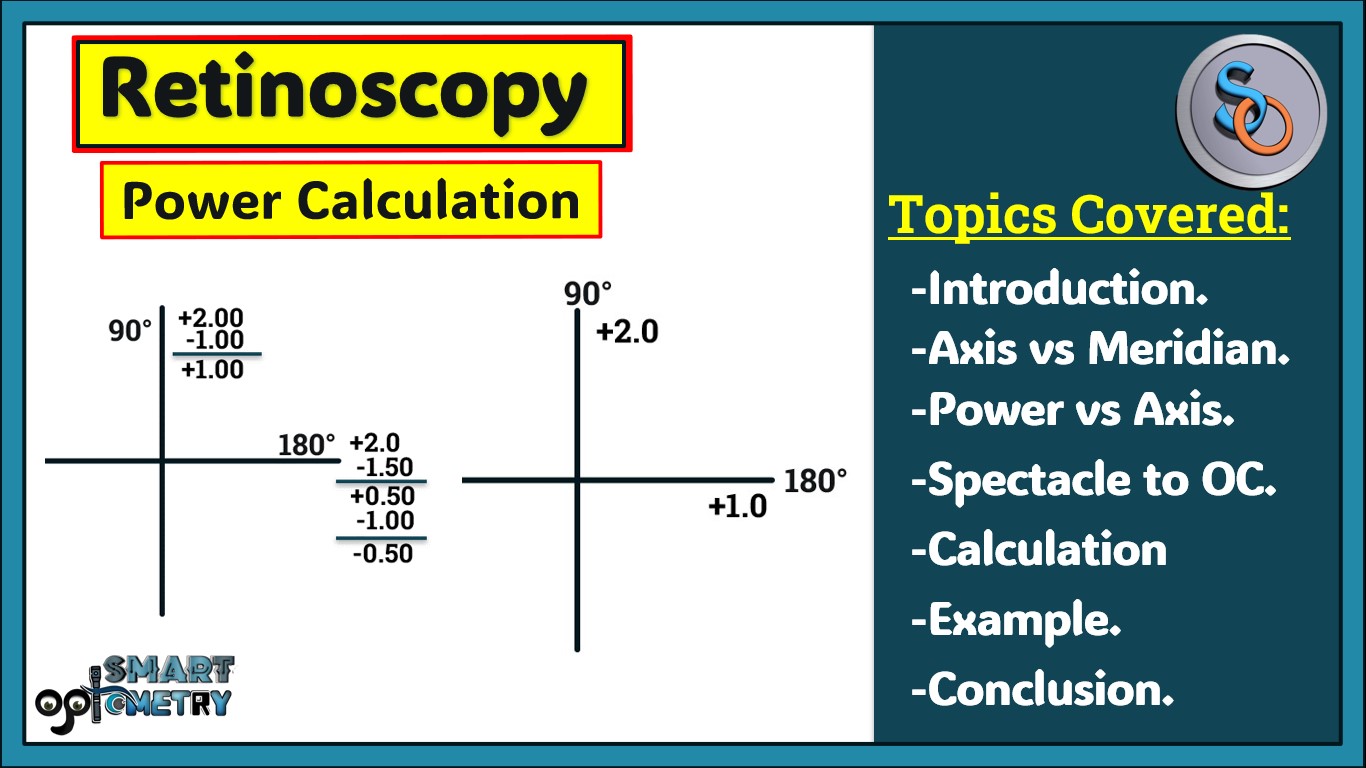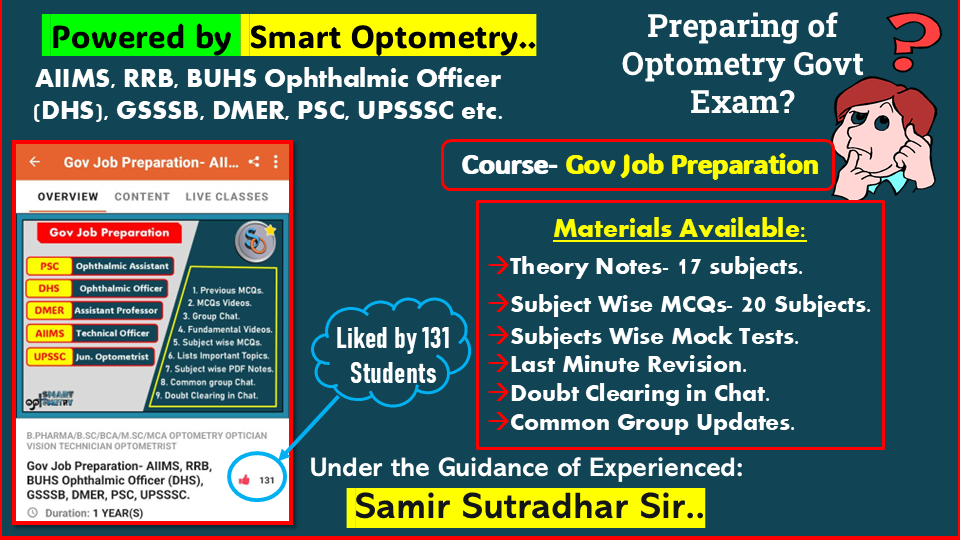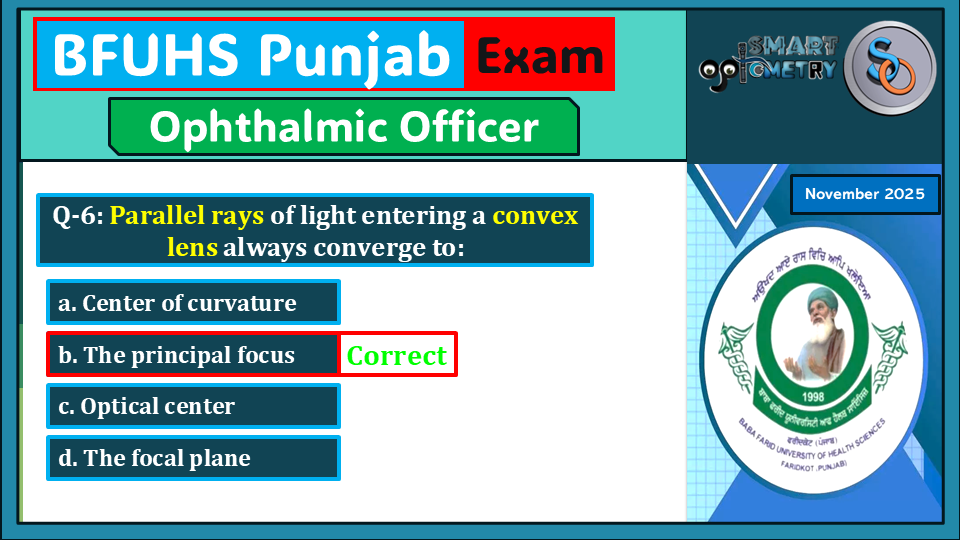Terminologies need to understand for Retinoscopy Power Calculation:
- Retinoscopy in clinical practice can be either:
- 1. Dry Retinoscopy
- 2. Wet Retinoscopy.
- The Retinoscopic power may be either:
- 1. Gross Retinoscopic Power
- 2. Net Retinoscopic Power.
- Other parameters are:
- 1. Working Distance Power.
- 2. Ciliary Tonus Power.
To do Retinoscopy power calculation, you need to know about these 6 Terminologies.
Dry vs Wet Retinoscopy:
Dry Retinoscopy:
- Retinoscopy that is performed without any cycloplegic Drug is called Dry Retinoscopy.
Wet Retinoscopy:
- Retinoscopy that is performed after applying cycloplegic drop or ointment is called Wet or Cycloplegic Refraction.
The difference between Retinoscopy power calculation of Dry and Wet Retinoscopy is that “In wet retinoscopy we need to subtract Ciliary tonus power and working distance power where in Dry retinoscopy we need to subtract only Working Distance power.”
Working Distance Power in Retinoscopy Power Calculation:
- We detect power of patient’s eye in the spectacle plane, but we don’t perform retinoscopy from spectacle plane rather from a certain distance (working distance) typically 67 cm.
- The power we get at 67cm is not the power that is required at spectacle plane.
- So, we need to subtract the distance from spectacle plane to Retinoscopy position to get power at spectacle plane.
- This distance can be subtracted by adding a certain power identify using the formula: 100/ Distance between spectacle plane & position of Retinoscopy (Working Distance) in cm.
- So, if we perform retinoscopy from 67cm (working distance) then to identify the power at spectacle plane we need to subtract the working distance power: 100/ 67 or 1.49 or 1.5D
Ciliary Tonus Power in Retinoscopy Power Calculation:
- During Retinoscopy, we need to identify patient’s refractive error without Accommodation being stimulated.
- To keep accommodation is at rest, we ask the patient to fixate 6/60 target at 6 meters.
- But some patients are not cooperative, instead of focusing 6/60 target they focus on retinoscopic light that induced some extra converging power and retinoscopy becomes inaccurate.
- In hyperopic patients, due to rays focusing behind the retina accommodation get stimulated automatically to reduce the blur retinal image that makes retinoscopy inaccurate.
- To avoid stimulation of accommodation, we use cycloplegic drugs to relax the ciliary muscles so that lens becomes flat (Relaxed), and Amplitude of accommodation becomes zero.
- Due to relaxing ciliary muscle more than required, lens becomes extra flat which induced some extra diverging or hypermetric power which is called Ciliary Tonus power.
- Ciliary Tonus power is not same for all cycloplegics:
- Atropine has +1.0D
- Cytopentolate has +0.75D
- Homatropine has +0.50D
Gross vs Net Power:
Gross Retinoscopic Power Calculation:
- The power we got without subtracting working distance power or ciliary tonus power is called Gross Retinoscopic Power.
Net Retinoscopic Power Calculation:
- The power we got after subtracting Working Distance power or Ciliary Tonus power (in Wet Retinoscopy) is called Net Retinoscopic Power.
- Net retinoscopic power is the actual refractive error of the patient.
Retinoscopy Power Calculation for Dry Retinoscopy:
Net Retinoscopic Power = Gross Retinoscopic Power – Working distance Power.
Retinoscopy Power Calculation for Wet Retinoscopy:
Net Retinoscopic Power = Gross Retinoscopic Power – (Working Distance Power + Ciliary Tonus Power)
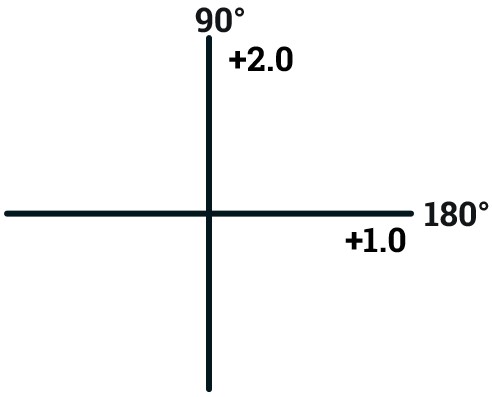
Gross Power availability:
- Gross Retinoscopic Power may be written as:
- 1. Sphero-Cylinder Format.
- 2. Meridian wise.
- 3. Axis wise.
- Above optical cross power can be written in 3 formats:
- 1. Sphero-Cylinder Format: +2.0/-1.0 x 90°
- 2. Meridian wise: +2.0 @ 90° & +1.0 @ 180°
- 3. Axis wise: +2.0 x 180° & +1.0 x 90°
Dry Retinoscopy Power Calculation from Optical Cross:
Example: If Gross power is +2.0DS / -1.50 X 90° with WD 100cm (1D), then what will be Dry Retinoscopic Power?
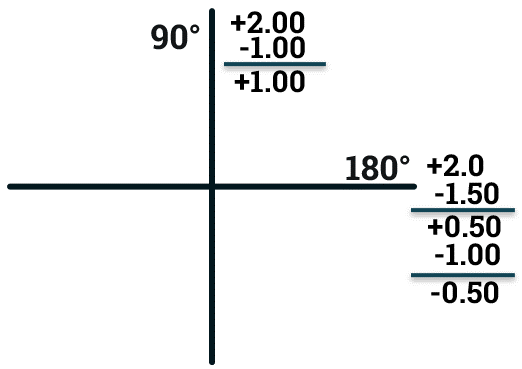
- Lets distribute the power meridian wise.
- Here two principle meridians are
- Spherical or Vertical Meridian: 90
- Cylinder or Horizontal Meridian: 180
- In the given example +2.0 is spherical power, so it will be in both meridians.
- -1.50 is cylindrical power and will available only in Horizontal Meridian.
- So we have in:
- Vertical meridian: +2.0D
- In Horizontal Meridian: +2.0 – 1.5 or +0.50D
- We know that the formula to identify Dry Retinoscopic Power is:
- Dry Retinoscopic Power = Gross Power – Working Distance Power
- So, in vertical meridian we have:
- Dry Retinoscopic Power = 2.0 – 1.0 or +1.0D
- In Horizontal meridian we have:
- Dry Retinoscopic Power = 0.50 – 1.0 or -0.50D
- We need to identify two powers:
- Spherical Power.
- Cylinder Power with Axis.
- For Spherical Power:
- Take Any meridian as Spherical power.
- For cylinder Power & Axis:
- Cyl Power will be difference between Cyl meridian & Sph Meridian.
- Cyl Axis will be 90 deg to Cyl meridian.
- Let’s Consider Vertical Meriden is Spherical:
- So, Spherical power will be: +1.00DS
- Cylinder Meridian is Horizontal:
- Cyl power will be: -0.50 – (+1.0) or -1.50
- Axis will be 90 to Cylinder Meridian or -1.50 X 90°
- So final power will be: +1.0 / -1.50 X 90°
One simple way is “Find the gross Retinoscopic power in sphero-cylinder format & subtract the working distance power from spherical power only to get Net Retinoscopic Power”
- For above Example: if Gross power is +2.0DS / -1.50 X 90°, Dry Retinoscopic Power will be:
- (+2.0 – 1.0) / -1.50 X 90°
- +1.0 / -1.50 X 90°
Wet/Cycloplegic Retinoscopy Power Calculation from Optical Cross:
Example: Gross power is +4.0DS / +1.00 X 90° with WD = 100cm (1D) after applying Atropine. What will be Net Retinoscopic Power?
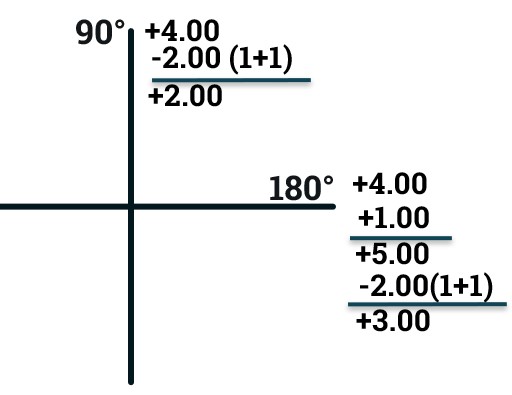
- Let’s distribute the power meridian wise.
- Here two principle meridians are
- Spherical or Vertical Meridian: 90
- Cylinder or Horizontal Meridian: 180
- In the given example +4.0 is spherical power, so it will be in both meridians.
- +1.0 is cylindrical power and will available only in Horizontal Meridian.
- So we have in:
- Vertical meridian: +4.0D
- In Horizontal Meridian: +4.0 + 1.0 or +5.0D
- We know that the formula to identify Net Retinoscopic Power of Cycloplegic/Wet retinoscopy is:
- Net Retinoscopic Power = Gross Power – (WDP + Ciliary Tonus Power)
- So, in vertical meridian we have:
- Net Retinoscopic Power = 4.0 – (1 WDP + 1 Ciliary Tonus power)
- Net Retinoscopic Power = 4.0 – 2.0
- Net Retinoscopic Power = +2.0D
- In Horizontal meridian we have:
- Net Retinoscopic Power = 5.0 – (1 WDP + 1 Ciliary Tonus power)
- Net Retinoscopic Power = 5.0 – 2.0
- Net Retinoscopic Power = +3.0D
- Now, we need to identify two powers:
- Spherical Power.
- Cylinder Power with Axis.
- For Spherical Power:
- Take Any meridian as Spherical power.
- For cylinder Power & Axis:
- Cyl Power will be difference between Cyl meridian & Sph Meridian.
- Cyl Axis will be 90 deg to Cyl meridian.
- Let’s Consider Vertical Meriden is Spherical:
- So, Spherical power will be: +2.0DS
- Cylinder Meridian is Horizontal:
- Cylinder power will be: +3.0 – 2.0 or +1.0
- Axis will be 90 to Cyl Meridian or +1.0 X 90°
- So final power will be: +2.0/ +1.0 X 90°
One simple way is “Find the gross Retinoscopic power in sphero-cylinder format, then subtract the working distance power & Ciliary Tinus Power from spherical power only to get Net Retinoscopic Power”
- For above Example: if Gross Cycloplegic/Wet power is +4.0DS / +1.00 X 90°, Net Retinoscopic Power will be:
- +4.0DS – (1 WDP + 1 Ciliary Tonus power)/ +1.00 X 90°
- +4.0DS – (1 WDP + 1 Ciliary Tonus power)/ +1.00 X 90° +2.0 / +1.0 X 90°
- Check Our Courses: Ophthalmic Instrumentation, Clinical Refraction, Contact Lens, Binocular Vision, Dispensing Optics, MCQs in Optometry
- Download our App “Optometry Notes & MCQs” from Google Play Store.

